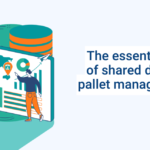3 KPIs to put your pallet flow under control
3 key performance indicators to manage your pallets efficiently
It does make sense to track your performance indicators for inventories, orders or various costs inherent to your supply chain, right?
But what about your Euro pallets?
Since more than 600 million units are circulating around the world, its crucial role as part of the supply chain is no longer in question. And even if the EPAL system is based on the rather simple principle of “consignment”, it can however provoke serious tensions between partners. This appears to be particularly true when the logistics players experience some difficulties trying to identify the retention areas, therefore locating their available pools.
Moreover, the geopolitical context is inducing a significant additional pressure on the market. We expect skyrocketing prices combined with less availability. In such circumstances, taking control over your pallet management is no longer an option, but a requirement. No pallets, no deliveries!
That’s why a strong follow-up of certain performance indicators (or KPIs) can optimize your pallet pool and thus reduce your costs.
Here is a suggestion of 3 key indicators to follow:
1. Ranking your accounts by partner
As part of your oversight, the ranking corresponds to the position of one of your partners in the global ranking of your pallet debts. It helps you to identify which partner should be notified first.
At a glance, you can see which one of your trading partners has the largest debt.
2. Restitution rate by partner
This is an excellent indicator to show the percentage of pallets returned, compared to the number of pallets loaded by your partner.
Example:
Your carrier returns 20 pallets after he loaded 100. His restitution rate is 20%.
We would recommend an agreement on a minimum restitution rate per month. This will allow you to articulate firmly your relationship with your partner and anticipate your needs.
3. Loading days coverage
The load coverage offers a detailed analysis of your exchanges by quantifying the debt of each partner and expressing it in number of loading days. It allows you to distinguish your providers according to their flow volumes (from the largest to the smallest).
Example :
If you assign 100 pallets/week to your provider and if he owes you 400, then he owes you the equivalent of 30 days of loading.
On the other hand, if you assign 1000 pallets/day and if owes you 3000, then it’s only 3 days of loading. A perfectly acceptable number.
To avoid unnecessary discussions with your partner, it would be better to agree on a certain number of days’ coverage, a limit not to be exceeded.
The importance of KPIs
Handling simultaneously these 3 key indicators will give you a complete and precise analysis of your partners’ performance. For example, a carrier may have the biggest debt, but represents only 4 loading days. Hence, he’s not going to be your priority… unlike a carrier with debt equivalent of 300 days. Consequently, when the yearly prescription is approaching, you will give priority to the latter.
Which tool should you choose to monitor these KPI’s?
Traditional tools used in a silo-based approach (TMS, Excel, extraction from your WMS…) do not allow an efficient management. Indeed, processing data manually via Excel takes a lot of time and always includes room for error. Moreover, it is often complex to provide proof of the quantities loaded or delivered in case of a disagreement on the pallet debt.
In the long run, this can damage the business relationship with your partner and bring on consequences on your pallet purchasing budget.
As long as there is no agreement on the debt, getting your pallets back will be delayed.
Why would you digitize your process?
If you don’t get shared information in real time with your partners, your management will definitely lack agility. Until you find an agreement on the quantities to be delivered, your entire supply chain loses responsiveness.
The advantage of having direct access to performance indicators on a dashboard is obvious! It allows control in real time and avoids various queries process in your information systems.
This is why it is essential to digitalize your management and extract your KPIs in two clicks.
And this is exactly what our collaborative solution offers you.
👉 Contact our experts to learn more.







